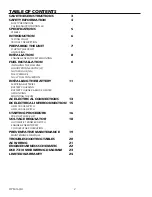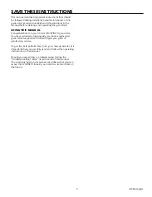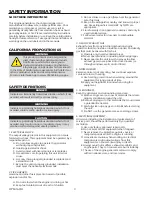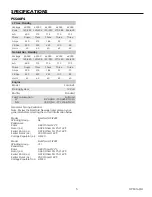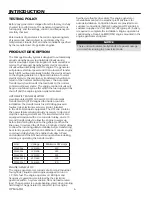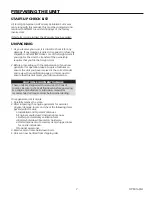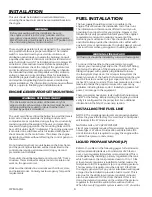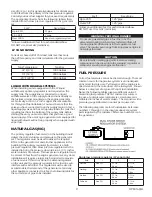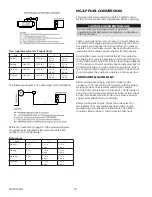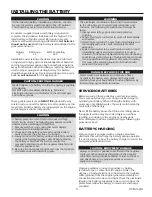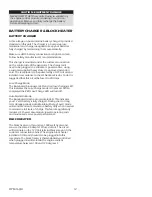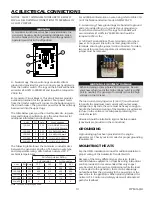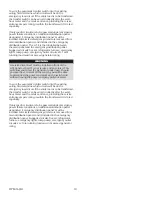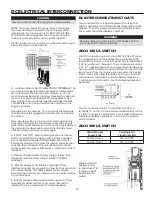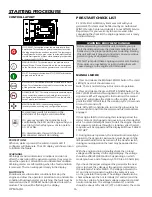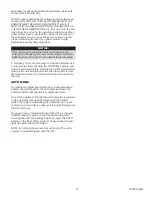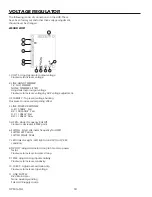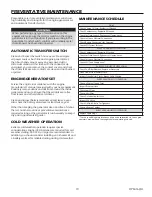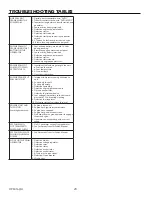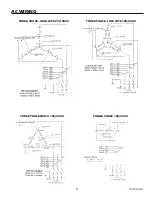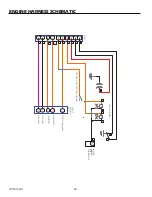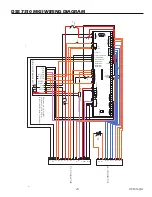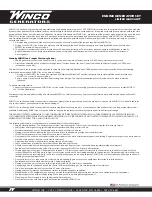
11
OPM-160/A
WARNING
The electrolyte is a diluted sulfuric acid that is harmful
to the skin and eyes. It is electrically conductive and
corrosive, The following precautions must always be
taken.
1. Always wear full eye protection and protective
clothing.
2. Where electrolyte contacts skin, wash off immediately
with water.
3. If electrolyte contacts the eyes, flush immediately and
thoroughly with water. Seek immediate medical
attention.
4. Spilled electrolyte is to be washed down with an acid
neutralizing agent. A common practice is to use a
solution of one pound of biocarbonate of soda (baking
soda) to one gallon of water. The biocarbonate of soda
is to be added until the evidence of reaction, foaming,
has ceased the resulting liquid is to be flushed with
water and the area dried.
DANGER: EXPLOSIVE FIRE RISK
Never smoke near batteries. Do not cause a flame
or spark in the battery area. Always discharge static
electricity from your body before touching batteries by
first touching a ground metal surface.
SERVICING BATTERIES
Batteries used on these units may over time lose water.
This is especially true if you are using a trickle charger to
maintain your battery. When refilling the battery with
water, use only distilled water. Tap water will shorten the
service life of the battery.
Never fill the battery above the fill line. Over filling above
the upper level line may cause electrolyte to overflow,
resulting in corrosion to the engine or nearby parts.
Immediately wash off any spilled electrolyte following the
procedure above.
BATTERY CHARGING
This generator is equipped with an engine mounted
alternator that will recharge the battery during operation.
It is not necessary to have the battery charger circuit on the
emergency distribution circuit.
CAUTION: EQUIPMENT DAMAGE
Always connect the positive cable first and the negative
cable last. When disconnecting, remove the negative
cable first and the positive cable last. Failure to connect
and disconnect in the proper sequence can cause
equipment damage.
Observe polarities: connect the positive (+) battery
terminal to the (+) cable from the engine starter; the
negative (-) battery terminal is connected to the negative
cable (ground) from the engine generator assembly. All
connections must be clean and tight. Check the electrolyte
(fluid) in the battery periodically to be sure it is above the
plates. Never allow the battery to remain in a discharge
condition.
INSTALLING THE BATTERY
CAUTION
In the following battery installation procedure, check to
be sure the selector switch remains in the ‘off’ position.
This should be your last step before initial start-up.
A customer supplied twelve-volt battery is required to
complete the installation. Installation of the highest CCA
rated battery, within the correct BCI group (size), will
increase cold weather starting performance.
Gel batteries
should not be used
with the battery tender installed in the
generator enclosure.
Voltage
BCI Group
MIN. CCA Rating
12
24
650
Installation and servicing of batteries must be performed
or supervised only by persons knowledgeable of batteries
and the required precautions. Keep unauthorized persons
away from batteries. When installing or replacing batteries,
use the proper group/size starting battery. The battery
should be a maintenance free lead acid design. Deep cycle
batteries
will not work
for this application.
CAUTION: PERSONAL DANGER
NEVER dispose of a battery in a fire. The battery is capable
of exploding.
DO NOT open or mutilate the battery. Released
electrolyte is known to be harmful to the skin and eyes
and to be very toxic.
These generator sets are all
NEGATIVE
ground. Be very
careful not to connect the battery in reverse polarity, as this
may short circuit the battery charging system on the engine
and damage electronic components.
CAUTION
A battery presents a risk of electrical shock and high
short circuit current. The following precautions must be
observed when working with batteries.
1. Remove watches, rings, and other metal objects.
2. Use tools with insulated handles.
3. Check both the battery cable ends and the battery
posts to be sure they are free of corrosion.
4. Always connect the battery positive cable first and then
connect the battery negative cable. When removing
the battery cables from the battery, reverse the
procedure and disconnect the negative cable first and
then the positive cable.
5. Be sure all connections are tight and coat the terminals
and cable ends with dielectric grease.


